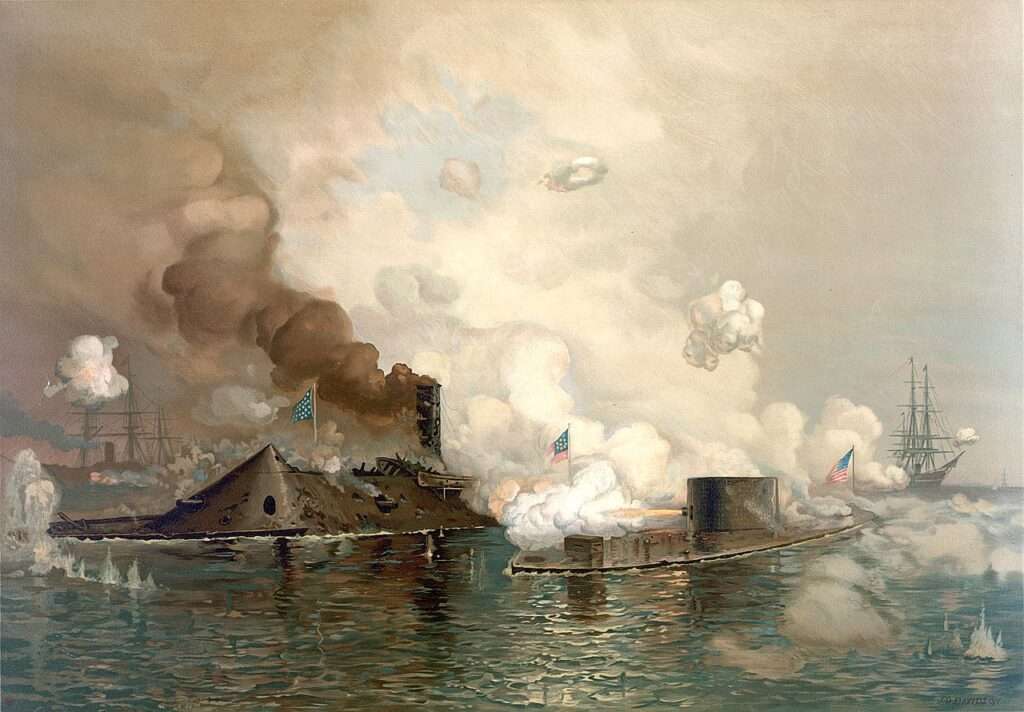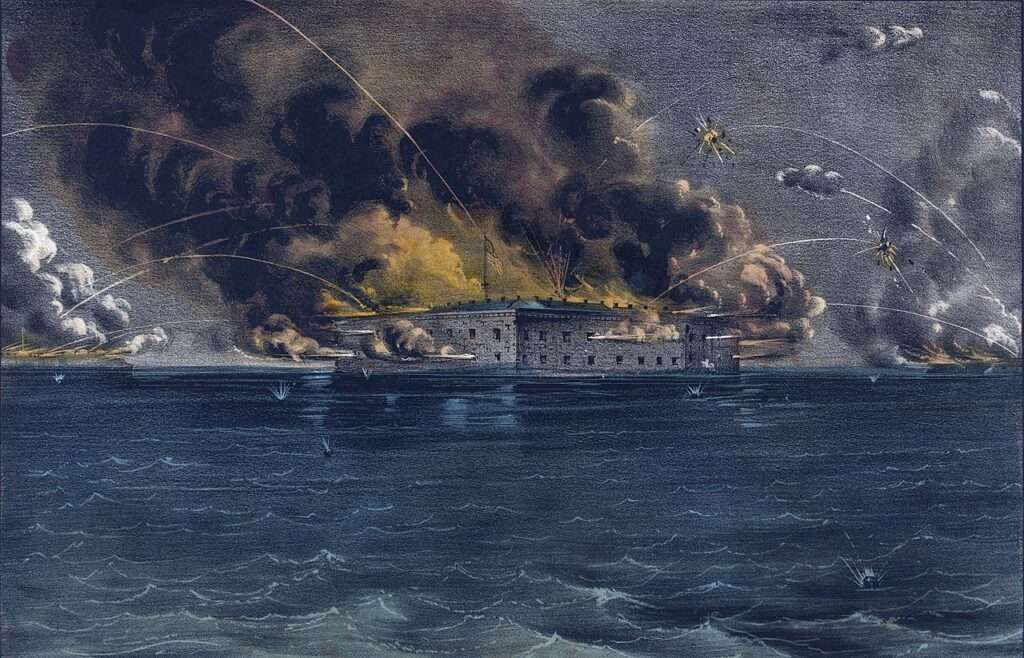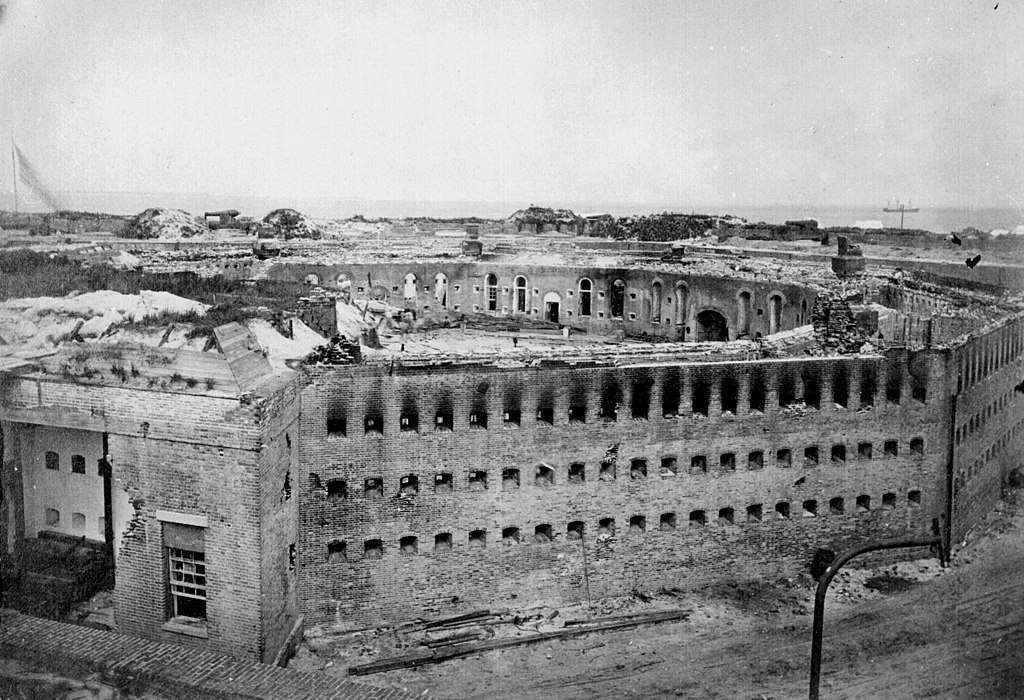The American Civil War (1861-1865) witnessed not only fierce land battles but also significant naval conflicts.

Sea warfare played a pivotal role in shaping the outcome of the conflict, as both the Union and Confederate forces sought to establish dominance on the water.
Here we’ll delve into the ships utilised by both sides, the emergence of ironclads, the introduction of submarines, the importance of coastal fortifications, and a major sea battle that left an indelible mark on naval history.
Ships Used by the Union and Confederate Forces
The Union Navy boasted a substantial advantage in terms of ship numbers and resources.
They utilised a wide array of vessels, including steam-powered warships, gunboats, and converted merchant ships.
Notable ships included the USS Monitor, USS Hartford, USS Kearsarge, USS New Ironsides, and USS Brooklyn.
These ships formed the backbone of the Union naval fleet, with the Monitor gaining fame as the first ironclad warship commissioned by the U.S. Navy.
The Confederate Navy, faced with limited resources, employed a strategy of commerce raiding, utilising swift and agile ships to disrupt Union supply lines.
The CSS Alabama, CSS Shenandoah, CSS Florida, and CSS Arkansas were among the most successful Confederate vessels.
These ships, often built in British shipyards, wreaked havoc on Union merchant vessels and threatened Union naval superiority.
The Emergence of Ironclads
The American Civil War marked the introduction of ironclad warships, revolutionising naval warfare.
The most famous engagement involving ironclads was the Battle of Hampton Roads in 1862.
 The first battle between ironclads in 1862 between the CSS Virginia (left) and the USS Monitor ended in a stand off. Both sides realised their importance.
The first battle between ironclads in 1862 between the CSS Virginia (left) and the USS Monitor ended in a stand off. Both sides realised their importance.
The Union’s USS Monitor, a steam-powered turret ironclad, faced off against the Confederate’s CSS Virginia, a converted steam frigate armoured with iron plates.
The clash between these two ironclads demonstrated their superiority over traditional wooden ships.
The Monitor’s innovative revolving turret provided unmatched firepower, while the Virginia’s armoured plating made it nearly impervious to enemy fire.
Though the battle ended in a stalemate, it highlighted the significance of ironclads and prompted further development in naval technology.
Submarines in the Civil War
The Civil War also witnessed the introduction of submarines, albeit in their early stages of development.
The Confederate submarine H.L. Hunley holds the distinction of being the first submarine to successfully sink an enemy warship.
In 1864, the Hunley attacked and sank the USS Housatonic, but tragically, it too sank shortly after the attack, claiming the lives of its crew.
 Looking somewhat futuristic for 1863 the H. L. Hunley submarine.
Looking somewhat futuristic for 1863 the H. L. Hunley submarine.
While the Hunley achieved a notable feat, submarines remained experimental and unreliable during the war.
Their limited range, susceptibility to mechanical failures, and the dangers associated with operating in a hostile environment hindered their widespread use.
Nevertheless, the use of submarines during the Civil War laid the groundwork for future advancements in underwater warfare.
Coastal Fortifications
Coastal fortifications played a vital role in protecting harbours and restricting enemy naval movements.
Both the Union and Confederate forces heavily fortified strategic locations along the eastern seaboard, including Charleston, South Carolina, and Norfolk, Virginia.
Fort Sumter, situated in Charleston Harbour, became a focal point of the conflict. The fort endured a protracted siege and numerous naval bombardments.
 The Battle of Fort Sumter during the US Civil war.
The Battle of Fort Sumter during the US Civil war.
Ultimately, it was the Confederate’s ability to defend Fort Sumter that prevented the Union from seizing control of the harbour.
In addition to Fort Sumter, other coastal fortifications such as Fort Monroe in Virginia and Fort Pickens in Florida served as crucial defensive positions.
These forts provided a formidable line of defence against naval attacks and secured vital coastal regions for their respective forces.
Fort Morgan
Fort Morgan was constructed in the 19th century to protect the entrance to Mobile Bay and its important port, which served as a major Confederate supply route. Construction of the fort began in 1819 and was completed in 1834.
It was named after Revolutionary War hero General Daniel Morgan.
The fort’s strategic location at the mouth of Mobile Bay made it a crucial defensive position.
Its purpose was to prevent Union forces from gaining access to the bay, protecting the city of Mobile and impeding Union naval operations in the region.
During the Civil War, Fort Morgan faced several significant engagements and a prolonged siege by Union forces.
The most notable conflict involving the fort was the Battle of Mobile Bay in August 1864.
In the Battle of Mobile Bay, the Union fleet, led by Admiral David Farragut, aimed to capture the fort and gain control of Mobile Bay.
Fort Morgan, along with the Confederate ironclad CSS Tennessee, played a crucial role in defending the bay against the Union forces.
Battle of Mobile Bay
The battle of Mobile Bay, fought in August 1864, was a pivotal engagement that showcased the significance of naval power. The Union forces, led by Admiral David Farragut, sought to seize control of Mobile Bay, a key Confederate port.
The Confederate forces, commanded by Admiral Franklin Buchanan, had established formidable defences, including the ironclad CSS Tennessee and a series of underwater mines.
Farragut’s fleet, consisting of four ironclads (USS Tecumseh, USS Manhattan, USS Winnebago, and USS Chickasaw) and a fleet of wooden warships, faced a treacherous gauntlet as they navigated the heavily mined waters.
Mine Warfare
The Confederates had laid a line of torpedoes, also referred to as “torpedoes” or “mines,” to obstruct the Union fleet’s progress.
As the Union fleet advanced, disaster struck when the lead ship, USS Tecumseh, struck a mine and sank within minutes.
Undeterred, Farragut famously exclaimed, “Damn the torpedoes, full speed ahead!” His fleet pressed on, skilfully manoeuvring around the mines and engaging the Confederate ships.
 A Panting of the Battle of Mobile Bay. Union ships faced the Confederate fort.
A Panting of the Battle of Mobile Bay. Union ships faced the Confederate fort.
A fierce naval duel ensued, with the Union ironclads exchanging fire with the CSS Tennessee.
Despite sustaining heavy damage from Union fire, the Tennessee valiantly fought back, targeting the Union ships.
However, the superior firepower and manoeuvrability of the Union ironclads eventually overwhelmed the Confederate vessel.
Barrage
In a daring move, the Union fleet closed in on the CSS Tennessee, engaging it at close range.
The Confederate ship found itself under relentless attack from multiple angles, leaving it crippled and unable to effectively retaliate.
The USS Hartford, Farragut’s flagship, delivered a devastating blow to the Tennessee, forcing its surrender.
With the CSS Tennessee neutralised, the Union fleet turned its attention to the remaining Confederate ships, which retreated towards the safety of the forts.
Despite sustaining losses and damage, the Union fleet succeeded in capturing Mobile Bay, effectively sealing off the port from Confederate use.
The Battle of Mobile Bay marked a significant victory for the Union, cutting off a crucial Confederate supply route and tightening the blockade along the Gulf Coast.
It also demonstrated the effectiveness of ironclads and highlighted the importance of naval dominance in the war.
Conclusion
The sea warfare during the American Civil War witnessed the deployment of a diverse range of ships, including ironclads and submarines.
The Union’s numerical advantage and superior resources enabled them to field a formidable fleet, while the Confederacy resorted to innovative tactics, such as commerce raiding, to challenge Union naval dominance.
The emergence of ironclads revolutionised naval warfare, as seen in the famous Battle of Hampton Roads, where the USS Monitor and CSS Virginia showcased their superiority over traditional wooden ships.
The introduction of submarines, though in their early stages of design, marked a significant milestone in underwater warfare.
Coastal fortifications played a crucial role in protecting harbours and impeding enemy naval movements.
Fort Sumter and other fortified positions along the eastern seaboard served as formidable defensive strongholds, influencing the course of naval engagements and preventing Union forces from gaining control of key strategic locations.
 Fort Morgan after its surrender following the Battle of Mobile Bay. Battleships and Ironclads won the day.
Fort Morgan after its surrender following the Battle of Mobile Bay. Battleships and Ironclads won the day.
The Battle of Mobile Bay, with Admiral Farragut’s bold “Damn the torpedoes” command, exemplified the importance of naval power in determining the outcome of the war.
The Union’s triumph in this battle further weakened the Confederacy’s naval capabilities and solidified the Union blockade, ultimately contributing to the Union’s victory in the American Civil War.
Sea warfare in the American Civil War showcased advancements in naval technology and strategies that would shape future conflicts.
The lessons learned from this pivotal period in naval history continue to resonate and influence naval warfare to this day.